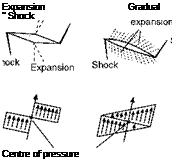Supersonic body shapes
The considerations which decide body shapes for supersonic speeds are similar to those which apply to wing sections. Bodies should be slender, but there are limits in practice owing to the need for room inside the body, for stowage, etc. All in all, the optimum fineness ratio is about 6 to 8 per cent.
 |
 |
Also for reasons of stowage and body capacity there are advantages in curves rather than straight lines, and in a rounded nose and tail (Fig. 12.25d). From the drag and speed point of view the nose should be sharp pointed, and often is; but there are disadvantages – the pilot’s view is bad (hence the droop-
Fig 12.24 Supersonic pressure distributions
(a) Pattern of shocks and expansions.
(b) Pressure distribution and centre of pressure.
snoot as on the Concorde), the sharp point is useless for stowage, and the transmission of radar pulses is unsatisfactory. The tail portion can be cut off, like the rear of a bullet, without much loss of efficiency; and this is necessary in any case when the jet or rocket efflux is at the rear of the body (Fig. 12.25b).
A body or fuselage of some kind is clearly necessary if the aircraft is to carry pilot, passengers, mail, or goods, and if the wings are to be thin – but are wings really necessary at supersonic speeds? Bodies can easily be designed to give lift (whatever their shape they will give lift at a small angle of attack), but cannot the thrust be used to provide the lift? In earlier chapters we talked of flying wing; why not a flying body?
Well, of course, a rocket can be nothing more nor less than a flying body – and more will be said about rockets in the next chapter – but even rockets need guidance and, within the atmosphere at least, guidance and control are best achieved by fixed and movable surfaces. There is also, so far as aeroplanes are concerned, the not unimportant point of getting back to earth.
But the reason for mentioning this problem is something quite different. One advantage in having a wing at supersonic speeds is that the presence of the wing improves the lift on the body – there is interference between wing and body, but it is useful interference; and it is mutually useful, because the body produces an upwash which improves the lift of the wing.
There are great possibilities in the exploitation of beneficial interference at supersonic speeds, and it is something which we may hear a lot more about in the future. Another example of it has already been mentioned in connection with putting a centre body at the inlet of a ramjet or jet engine. A suggestion has even been made of beneficial biplane effects, by eliminating external shock bow waves, and using the shock between the wings to good effect as in an engine intake – perhaps making the biplane the engine. Who knows?
A form of area rule is still effective in reducing shock drag at supersonic speeds, but its application is rather more complicated. Since the shock waves and Mach Tines are now oblique, instead of being at right angles to the flow, the ‘area’ which must change smoothly is not that at right angles to the line of
![]()
![]()
![]()
![]()
Rounded
Fig 12.25 Supersonic body shapes
flight, but in planes parallel to the Mach Lines. And unfortunately the inclination of the Mach Lines depends on the Mach Number at which the aircraft is flying, so the shape of the aircraft can only be correct for a particular Mach Number.











